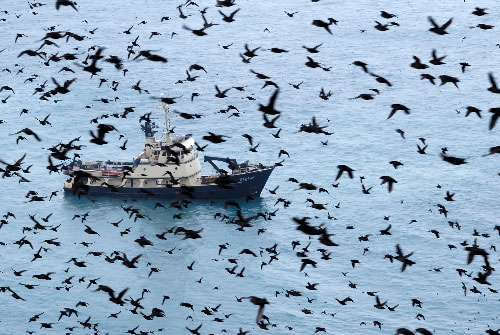
40 Years of North Pacific Seabird Survey Data Now Online
July 19, 2015
“The database offers a powerful tool for analysis of climate change effects on marine ecosystems of the Arctic and North Pacific, and for monitoring the impact of fisheries, vessel traffic and oil development on marine bird communities over a vast region,” said Dr. John Piatt, head of the Seabird and Forage Fish Ecology Research Program at the USGS Alaska Science Center. “It also creates an unprecedented opportunity to study the biogeography and marine ecology of dozens of species of seabirds and marine mammals throughout their range in continental shelf waters of the United States.”
U.S. Fish and Wildlife Service vessel Tiglax off of Kasatochi Island, Alaska, as seen through a flock of Crested Auklets. Location: Bering Sea
The surveys were conducted over four decades as part of focused studies, for various purposes and in specific regions within the North Pacific. Hundreds of observers from dozens of international, federal and state wildlife agencies, universities and consulting companies contributed data. Because similar observational methods were used, the data could be compiled into a single database, shedding light on broader patterns of seabird distribution and abundance. USGS scientists started compiling the data into the NPPSD in 2001 and published the first version in 2005. This is the first time the database has been made available online. The current version includes surveys conducted in the last decade and from additional regions. The compilation of data from surveys spanning 40 years makes the NPPSD one of the largest marine wildlife censuses ever conducted in terms of the number of animals observed and spatial extent of the survey area. “Contributors to the NPPSD can now examine large-scale phenomena that were previously impossible for individual studies to assess because they were conducted on smaller temporal and spatial scales,” said Dr. Gary Drew, database manager for the Seabird and Forage Fish Ecology Research Program at the USGS Alaska Science Center. The value of the NPPSD for understanding the ecology of the North Pacific and the impacts of human activities in this region has just begun to be realized. Recent analyses using NPPSD data included a risk analysis of shipping traffic on seabirds in the heavily traveled Aleutian Islands conducted by the U.S. Fish and Wildlife Service, and a study commissioned by the National Audubon Society to identify “Important Bird Areas” from California to Alaska. Future analysis of the database by USGS scientists aims to yield many insights into the status of seabird and marine mammal populations, while the live online database meets the Obama Administration’s directive of "Expanding Public Access to the Results of Federally Funded Research."
Edited by Mary Kauffman, SitNews
On the Web:
Source of News:
|
||
